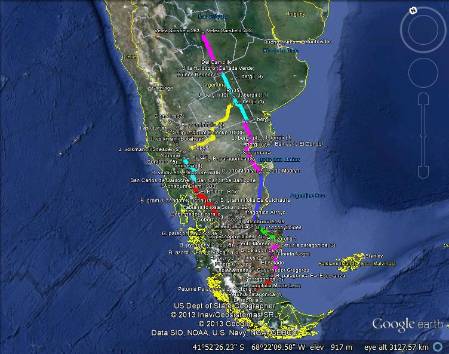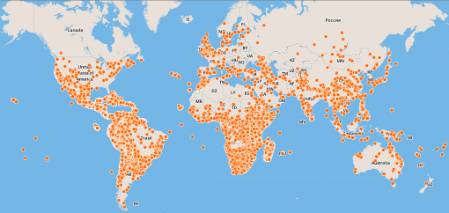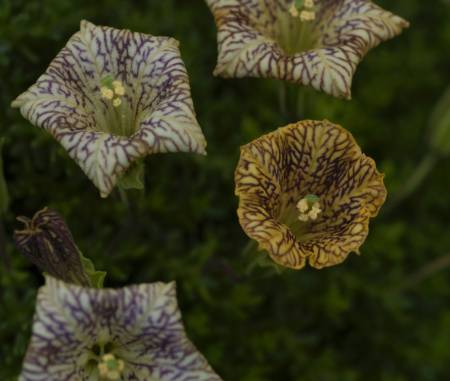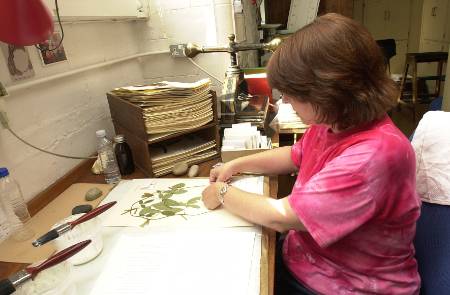21st March – Neotypifying, and yet again, neotypifying
Panic over! We found cash and didn't have to wash any dishes. It was the well known classic "going to the bank" method that saved us . Lucky we had some US dollars to change into Peruvian nuevo soles. Still running strong, fuel in the car, food in the stomachs, and money burning in the pockets .
Yesterday we drove all day for nearly 300 km on small mountain roads just to get to Sandia. The reason we so desperately want to collect around here is that there are two species described from around Sandia that need re-typification. This is because the material that was used to describe these species, i.e. their type collections, were destroyed during the Second World War in the Berlin herbarium. To replace the lost types, new types need to be made, and this process is called neotypification.
The two types we wanted to recollect were for Solanum planifurcum and Solanum sandianum. Both species were described by Bitter, S. planifurcum from the outskits of Sandia from 2100 – 2500m elevation, and confusingly, S. sandianum from higher up above Cuyocuyo, a town c. 20 km from Sandia, at 3800 m elevation. Some claim these species are synonyms, and represent just extreme variation of a single species. Today we shall see!
We started our morning from Sandia near S. planifurcum type locality, and luckily found a population just outside Sandia in 2100 m elevation.
.JPG)
We kept collecting populations until 2500 m, and observed variation along the elevational gradient. Further up, all the way to 3200 m we could observe populations of S. planifurcum. Then gradually, things started to change. At 3400 we found what Bitter would have called S. sandianum, just outside Cuyocuyo, in the local rubbish dump. Not a pretty collection locality, I admit, but there is was.
.JPG)
Solanum sandianum seems to have narrower leaves, which are less hairy and shiny above. Flowers vary in colour, but in general they are dark purple rather than pale lilac as Solanum planifurcum. Calyx shape and size, corolla, stamens and style characters seem to vary less. But are the differences in leaf shape, size and indumentum enough to justify recognising two species? We discussed this with Paul and decided that this is a perfect case where molecular sequence data can help us to decide. If molecular data gives evidence that these taxa are not sister to each other, then we will look for morphological differences that could be used to distinguish them. If, on the other hand, molecular data shows these individuals from different elevations along the road from Sandia to Cuyocuyo to be all mixed within a single clade, I think the case is clear for sunking these names for synonomy!
Having done a good days work in collecting along the gradient from Sandia to Cuyocuyo, we were heading back towards Juliaca. As we got closer to the city, we opted to drive all the way to Puno for the night as the city is famous for its beautiful location on the shore of Lake Titicaca.
.JPG)
The roads weren’t great, and again, we arrived to Puno very late at night. We managed to find a hostel without trouble this time. It was time for some relaxation, and winding down after a long drive. Lucky for the boys, there was a footfall game on in the evening, Peru was playing against Chile! Tensions were high, it was 0-1 for Chile for long time, and although Peru managed to score before too long, Chile eventually won. The boys were sad, some tears were shed, but I consoled them by reminding them that there was the beautiful view of Lake Titicaca to see in the morning.
22nd March – Views over Lake Titicaca
I always thought as a child that Lake Titicaca was a hot place with sandy beaches and tropical fruits all over. Just to clarify, this was not the fault of the Finnish education system at all. I just had manage to form this image in my head that Lake Titicaca was a place for sunbathing.
The truth is very different. Lake Titicaca is the highest elevation lake in the world, and it is not that warm.
.JPG)
Again we had a long drive ahead of us, we had to make some miles to make it across the Andes for the final time. This time we were crossing the Cordillera Occidental to the coastal deserts near Moquegua. It’s a long 7 hour drive from Puno to Moquegua, and this is without any collecting or taking side roads. Of course we couldn’t avoid the temptation to take few sideroads, but just enough to collect few Solanum fragile specimens near Puno.
.JPG)
Solanum fragile is the panda of the Solanum world – it’s flowers are cute as buttons! The calyx lobes are shy but showy, just a little bit recurved as you can see in the picture, and then the stigma! See how long it is, it’s excerted more than the length of the stamens! The species grows high up around 4000 m elevation, in rock crevases – despite this it has all the elegance of a high society lady with light blue petals, large corollas, and the showy appearance!
And of course there was Salpichroa hiding amongst the rocks as well! Salpichroa glandulosa is distinct amongst the genus having very densely hairy leaves.
.JPG)
We dissected a flower in the field, and discovered that the nectary disk at the base of the corolla tube is orange!
.JPG)
The slopes on the western side of the Andes near Moquegua are extremely dry and sandy. At 4400 m elevation there was sand everywhere. We kept looking for our sand loving friend Solanum chamaesarachidium, but couldn’t find it. I doubt it occurs this far west, the only populations known from Peru are in Puno.
.JPG)
The western slopes lower down are home for the Regmandra and the tomato clade of Solanum. We collected Solanum peruvianum along the road at around 2500 m elevation, a wild species related to tomato.
.JPG)
.JPG)
Today finding a hotel was easy – we hailed one from the car!!!! We got to Moquegua late, and we were tired. On a tight street just near the main Plaza of the city, whilst waiting for a traffic jam to clear, we manage to find a hotel on our left with their carrage door just a meter from our car, and that was it! We hailed the owner to open the doors before causing too much of a chaos on the street, and checked ourselves in. Sometimes it is easy, sometimes not…
23rd March – Flowers of the dry hills
Having slept peacefully, we headed out early to hunt for a collection I had seen in the herbarium in Lima. It was a specimen near Torata near Moquegua, that resembled Solanum arequipense, a species that has remained mysterious since its original description by Bitter. As for some other species of Bitter, the type of Solanum arequipense was destroyed in the Berlin fire during the Second World War. Without the type, the species has remained elusive and despite the name having been used in various floristic accounts, nobody really knows what the species is really like and what entity the name really refers to.
But there it was, just next to Quebrada Torata. This taxon is very similar to Solanum aloysiifolium, species that is found in northern Argentina and Bolivia. My colleague Gloria (see Argentina blog) will find these photos very exciting! Despite the similarity, this species is definetely something different. The leaves vary from entire to serrate, stamens are c. 3 m long, style clearly excerted, with a very capitate stigma.
.JPG)
.JPG)
The calyx lobes are larger than in Solanum aloysiifolium, and most importantly, the fruits remain green when mature. The fruits are speckled with these white small dots, which I first thought to be nothing special. But every fruit, in every individual we have seen, seems to have them.
.JPG)
We also collected another wild tomato species, Solanum chilense. It grows lower down in elevation.
.JPG)
Another new species for the day was Solanum corymbosum, a member of the Solanum section Parasolanum group. These species are related to Solanum section Solanum. They all have small flowers with tiny anthers, but with large stigmas. Solanum corymbosum occurs in low elevation dry habitats, whilst the others occur at slightly higher elevation. Solanum corymbosum has cute red fruits that resemble mini-tomatoes.
.JPG)
.JPG)
In the extremely dry habitats we passed near Omate we collected Exodeconus
.JPG)
.JPG)
and Nolana, both genera of Solanaceae specialised in desert habitats.
.JPG)
.JPG)
The day was getting late, and we were still in the middle of the desert, slowly ascending to the mountains on our way to Arequipa. It was getting dark, and we were aware that we would be arriving late to Arequipa that night. Except that suddenly we realised we were not going to arrive to Arequipa at all: we had a punctured front left tire! We also had a slow puncture in our back left tyre, and although this tyre looked still OK, air was coming out more and more rapidly.
So punctures in both of our left hand side tyres, what could we do? We took our spare out, thinking that changing the flat tyre from the front could get us as far as Arequipa, three hours away. Andrew and Paul took the spare down from its hiding place, and started changing the tyre. In less than 30 minutes, they were putting bolts on and tightening the spare – we were nearly ready to go again! Except that the spare turned out to be flat as well…
There was nothing else left to do except to take the spare and walk to the next village to get pumping. I stayed in the car, guarding our poor Freddy as we call our handsome 4by4. The spot were we had had to stop was a dangerous one – there was not adequate space to easily get pass our Freddy if busses or trucks would turn up. I was equiped with a powerful head torch, and hazards triangle which I put on the road.
By the time boys headed to the village with the spare tyre, it was pitch black. There I was, finally having an opportunity to breath, enjoy an evening by myself and watch the starts on the clear Andean sky. Beautiful! This is how it looked before going totally dark. I stopped taking photos in the dark as star skies never turn up nice but trust me it was beautiful.
.JPG)
Temperatures rocket down during nights in the Andes, so I stayed inside the car, keeping myself warm, waiting for any passersby. Nothing came for nearly an hour, but then I finally saw lights in the night sky, coming from behind the nearby curve. It was a truck!!! I took my headtorch, shone to indicate our poor positioning in the middle of two curves on narrow part of the road, and hoped that they would slow down before passing Freddy which was missing its both left handside tyres.
.JPG)
The truck barely slowed down. It took a milly second to observe the situation and the narrow space before taking its decision to go for it. The truck passed well, which was good news. This meant buses might be able to pass as well, and we knew to expect a bus soon.
Boys returned with bad news: the spare tyre was not only flat but with a massive hole in it.
So with three flat tyres and two OK ones, we had no option than to split our team. Paul with his peruvian fluency offered to head to Arequipa with two tires, so that he could return by next morning with repairs. Luckily a car passed by to give Paul a lift. Andrew and I stayed with the car. How would our night in Freddy go – and would the busses get through? We were nervous, but the stars were giving us comfort.








